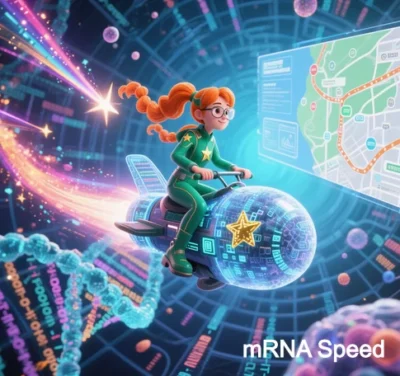
mRNA Speed: Accelerated Development and Production Technologies
mRNA Speed refers to the end-to-end acceleration of mRNA vaccines and therapeutics from sequence design to large-scale production. By integrating modular platforms, synthetic biology innovations, and industrialized manufacturing systems, this technology has revolutionized traditional drug development. Below, we analyze its practical applications and core advantages:
I. Practical Applications
1. Rapid Response to Infectious Diseases
- COVID-19 Vaccine Development:
- During the 2020 pandemic, Moderna developed the mRNA-1273 vaccine from sequence design to clinical batch production in 63 days. Pfizer/BioNTech’s BNT162b2 achieved regulatory approval in 326 days—90% faster than traditional vaccines.
- Key Innovations:
- No Viral Cultivation: Direct mRNA design based on viral genetic sequences (e.g., spike protein), bypassing live virus amplification.
- Modular Platform Reuse: Existing lipid nanoparticle (LNP) delivery systems can be rapidly adapted to new antigens by modifying mRNA sequences.
- Influenza Vaccine Updates:
- Moderna’s mRNA-1010 influenza vaccine covers four strains in 6–8 weeks, compared to 6+ months for egg-based methods.
2. Dynamic Adjustments in Cancer Therapy
- Neoantigen Vaccines:
- BioNTech’s FixVac platform designs personalized neoantigen mRNA vaccines in 4 weeks using tumor biopsy sequencing, targeting 20+ tumor antigens (e.g., melanoma, head and neck cancers).
- Resistance Monitoring:
- In EGFR-mutant lung cancer, mRNA technology tracks resistance mutations (e.g., T790M) in real time, enabling rapid adjustments to target EGFR-C797S.
3. Pandemic Preparedness
- RSV Vaccine Development:
- Moderna’s mRNA-1345 (targeting prefusion F protein) advanced from antigen design to Phase III trials in 18 months—3x faster than subunit vaccines.
- Zika Virus Response:
- The ZIKV-001 mRNA vaccine transitioned from sequence release to animal testing in 10 weeks during the 2016 outbreak.
II. Core Technical Advantages
1. Sequence Design Acceleration
- AI-Driven Optimization:
- Deep learning algorithms (e.g., SpliceBERT) predict mRNA secondary structure stability and optimize codon usage. Moderna’s platform boosts mRNA expression by 50% and reduces design cycles to 72 hours.
- Antigen Prediction:
- NLP-based models (e.g., DeepVac) identify immunogenic epitopes. For example, the S-2P conformation in COVID-19 vaccines increased neutralizing antibody titers 10-fold.
2. Standardized Manufacturing
- Enzymatic Synthesis:
- T7 RNA polymerase-based in vitro transcription (IVT) produces 10¹⁸ mRNA copies per batch—10⁴x more efficient than cell culture.
- Single-Step Purification:
- JUSHI Bio’s co-transcriptional capping achieves >90% mRNA purity via affinity chromatography, cutting purification time by 3 days.
- LNP Industrialization:
- Microfluidic mixing achieves >95% LNP encapsulation at 100,000 doses/minute (e.g., Moderna’s Norwood facility), with one LNP formulation adaptable to multiple mRNA drugs.
3. Modular Platform Efficiency
- Plug-and-Play Systems:
- BioNTech’s Mutanome platform includes:
- Replacing the antigen database reduces IND preparation from 18 to 6 months.
- Universal Quality Control:
- Standardized critical quality attributes (CQAs) for mRNA integrity and LNP size enable 90% shared analytical methods across products.
4. Mutation Response Agility
- Rapid Sequence Iteration:
- Moderna adjusted mRNA-1273.214 for Omicron in 30 days, versus 6 months for recombinant protein vaccines.
- Multivalent Vaccines:
- Moderna’s mRNA-1083 combines COVID-19 (Beta) and influenza (H1N1/H3N2) antigens via modular assembly, cutting development time by 60%.
III. Foundational Technological Breakthroughs
1. Synthetic Biology Innovations
- Modified Nucleotides:
- N1-methylpseudouridine (m1Ψ) extends mRNA half-life from 4 to 72 hours, boosting protein expression 100-fold.
- Self-Amplifying RNA (saRNA):
- Alphavirus replicase genes extend expression to 28 days per dose, reducing vaccine dosage to 1/10.
2. Delivery System Advances
- Organ-Targeted LNPs:
- CSPC’s CNS-targeted LNPs (with CL-301 lipid) improve brain delivery efficiency 5x for neurodegenerative therapies.
- Thermal Stability:
- CureVac’s RNActive platform enables 24-month mRNA vaccine storage at 2–8°C via lyophilization.
3. Industrial Manufacturing
- Continuous Production:
- Moderna’s end-to-end system produces mRNA from plasmid DNA to fill-finish in 18 days—40% faster than batch processing.
- Digital Quality Control:
- Process Analytical Technology (PAT) and AI models reduce batch variability from ±15% to ±3%.
IV. Future Acceleration Strategies
- AI-Lab Integration:
- Integrate AlphaFold-predicted protein structures with mRNA stability models for automated drug design (e.g., Recursion’s BioMIA).
- Rapid Clinical Validation:
- Organ-on-a-chip systems simulate human immune responses, compressing preclinical timelines from 12 to 3 months.
- Decentralized Production:
- Desktop mRNA synthesizers (e.g., DNA Script) enable hospital-based personalized cancer vaccine production in 72 hours.
Conclusion
mRNA Speed redefines biopharmaceuticals through digital design (AI), modular production (synthetic biology), and industrialized quality control (continuous manufacturing). Beyond pandemic preparedness, it establishes a rapid-response framework for prevention, therapy, and personalized medicine. With AI and automation, mRNA drug development could shrink to 30 days, ushering in an era of on-demand therapeutics.
Data sourced from public references. Contact: chuanchuan810@gmail.com.





